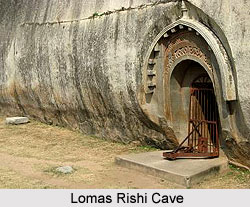 Two inscriptions from the later Gupta period (7th-8th centuries AD) both refer to kings Shardulavarman and his son Anantvarman of Maukhari dynasty. Another inscription is in Brahmi and was found in the cave.
Two inscriptions from the later Gupta period (7th-8th centuries AD) both refer to kings Shardulavarman and his son Anantvarman of Maukhari dynasty. Another inscription is in Brahmi and was found in the cave.
Geography of the Lomas Rishi Cave
The Barabar hills are situated 14 Km. East of Makhdumpur railway station in Jehanabad and Lomas Rishi Cave is carved into the hard monolithic granite rock face of Barabar hills, flanked to its left by the smaller Sudama cave. It is 24 kilometers away from Gaya in the Jehanabad District of Bihar and 11 kilometres from Makhdumpur Block HQ. The rock cut caves are the earliest examples of cave Architecture in north India.
History of the Lomas Rishi Cave
During the reign of Ashoka, these caves were excavated for the ascetics of Ajivika sect. These are known as Sudama, Vishwajhopri, Karnchaupar and Lomas rishi and are excavated in the hard granite with care.
Architecture of the Lomas Rishi Cave
Barabar, Dharawat and Dabthu have given up remarkable archaeological finds. The frontage of the rock-cut cave is in the shape of a hut supported by wood bars and has a doorway that is complicatedly sliced to duplicate timber architecture.
The decoration on the "curved architrave" consists of figures of elephants on their way to the stupas. Inside the tunnel there are two rooms. One is a large hall, rectangular in shape, which purposed as an assembly hall. More within is a second hall, smaller in size, which is an oval-shaped room with a roof in the form of a arena. The interior surfaces of the chambers are very finely finished.
This article is a stub. You can enrich by adding more information to it. Send your Write Up to content@indianetzone.com



















